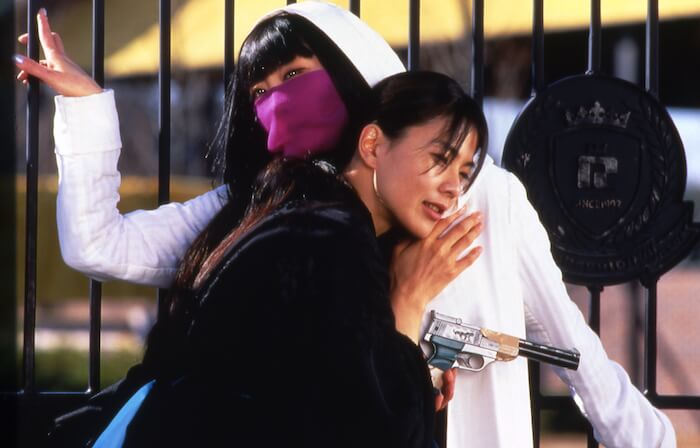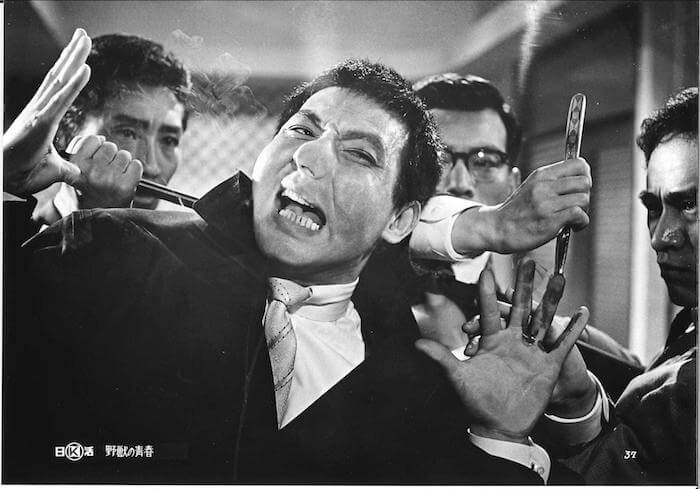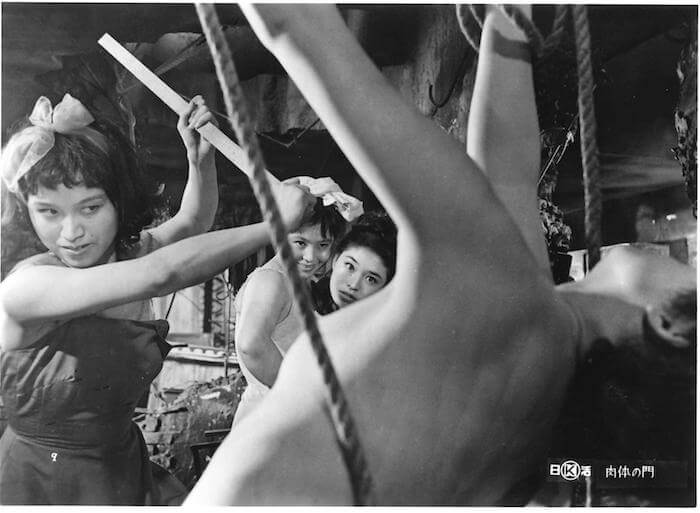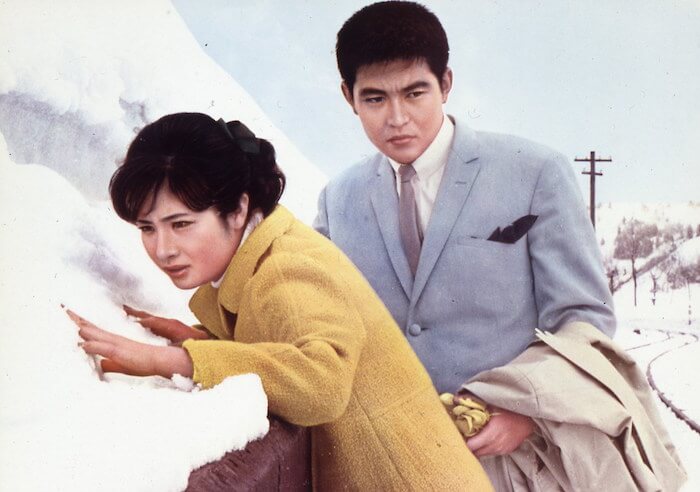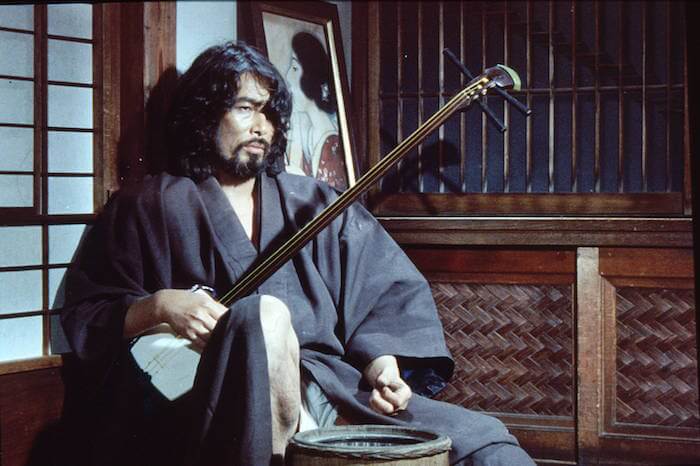The Visionary Nonsense (and Sneaky Emotion) of Seijun Suzuki
Action and Anarchy: The Films of Seijun Suzuki
November 6-17 at the Film Society of Lincoln Center
Timed to coincide with the release of Tom Vick’s Time and Place are Nonsense: The Films of Seijun Suzuki, this series offers 21 of the maverick director’s films—a healthy sampling of his massive output that manages to go beyond the canonical mid-60s gangster movie style experiments for which the retired 92-year-old auteur is best known. The book’s title is Suzuki’s own characterization of his films, and while it shortchanges the pivotal fact of many of them being set in a rattled postwar Japan or the Taisho era (1912-26), it gets at the point that his film’s concerns are consistently aesthetic more than humanist or historical. If that sounds like a recipe for vapidity, these concerns are overwhelmed by the obsessive uniqueness and emotional excess of the best work, for Suzuki the studio employee was a master smuggler of his own personal neuroses into his works-for-hire. The filmography is too unwieldy and eras-spanning for a tidy summing up of themes, but the ever-present visual wit (aided by collaborators like art director Takeo Kimura and cinematographers Shigeyoshi Mine and Kazue Nagatsuka) and subversive rascality brands each as a Suzuki picture.
In 1954, Nikkatsu Studios poached Suzuki from Shochiku, where he’d been toiling and learning on the job as an assistant director. Two years later he was directing the first of what would be 40 movies for Nikkatsu, largely B movies with limiting budgets and schedules, but less studio interference than the As. Between 1954 and 1968, he averaged 3 ½ movies per year for the studio, mostly in the yakuza mold. This grueling pace may have produced some forgettable detritus, but it offered Suzuki an incomparable education and the unintended fringe benefit of wearing him down with boredom, sparking his wild experimental streak that began in earnest with Youth of the Beast (1963).
The Film Society’s series offers some pre-breakthrough titles that, beyond their entertainment factor as confidently assembled actioners, augur the later farewell to realism and narrative neatness. In the earliest film here, the 77-minute Eight Hours of Fear (1957), a busful of character types are attempting to reach Tokyo after a train breakdown. As the rickety bus traverses the cliffside route, a miniature, proto-Speed drama unfolds inside, featuring a sympathetic murderer, a cop, a drunk, a baby and her single mother, a bookworm, a henpecked husband and eventually a group of nihilistic robbers who rappel in from another mountain. Passport to Darkness (1959) is a worthy addition to the grand subgenre of blackout-drunk murder mysteries, in which a trombonist’s new wife goes missing and he comes to to her dead body in his apartment after an ill-advised search/bender. Dark Tokyo streets, endless neon and moody jazz ballads are the noir signposts in this cousin to James Whale’s Remember Last Night? and Fritz Lang’s The Blue Gardenia.
Two other solid noirs from 1960, Smashing the O-Line and The Sleeping Beast Within, are here, but it’s with Youth of the Beast that things start to get peculiar, initiating a period of stylistic experimentation and a virtual war against his prescribed subject matter that made Suzuki a favorite with Japanese student cinephiles but an irritant to his employers. The film opens in black and white before a few flowers stand out in vivid pink (a trick Suzuki would return to elsewhere), and then the whole CinemaScope (rebranded “Nikkatsu Scope”) frame turns flamboyantly colorful for the duration. In the second of his high-profile collaborations with Suzuki, putty-cheeked Joe Shishido (who actually had undergone cheek augmentation surgery to give his face more character) plays a disgraced ex-cop now operating as a sort of in-between man, double- and triple-crossing rival yakuza gangs in the service of a private vendetta. Suzuki’s influence on later filmmakers like John Woo and Quentin Tarantino becomes clear here, in the cool charisma of its dapper killers and the chaotic modernism of its borderline-comical fight scenes.
With Gate of Flesh (1964), a personal favorite of mine, Suzuki stepped aside from the yakuza genre for something closer to the psychosexual territory of his coeval Shohei Imamura, another leading Japanese New Wave figure who similarly pushed his luck at Nikkatsu with his own visionary experimentation. It’s a bizarre look at a group of tough, color-coded prostitutes working out of a bombed-out basement in Tokyo immediately after the war, with gawking, strutting US soldiers/customers still lining the streets. A postwar uncertainty and horror has made the women mean (“We should spit on everything!”), ruthless capitalists. Giving it away for free is the cardinal sin, and when one of the clique does it, she is stripped, strung up, whipped bloody and slashed. Their self-sufficient microcosm is disrupted by the arrival of Shin (Shishido), a former soldier who needs a hideout after stabbing an American GI and swiftly ensorcells the gang with his vulgar masculinity (at one point he brings a stolen cow downstairs and slaughters it in the middle of the room). The Suzuki of this era is not a master psychologist, but his sparing use of superimpositions and raked angles tease out the teetering insanity and claustrophobia that the women mask with attitude. By the end, the portrayal of Maya (Yumiko Nogawa), who falls hardest for Shin, reaches true pathos as she mourns his disappearance by a filthy canal.
The intense, pouty Nogawa would make two more films with Suzuki (taken together, dubbed The Flesh Trilogy). In Story of a Prostitute (1965), she is one of a handful of working girls servicing an entire battalion of soldiers in Manchuria during the second Sino-Japanese War and buildup to World War II. Her Harumi is indentured to the boorish Adjutant, but she loves Pvt. Mikami (Tamio Kawachi) so much that, in a bravura sequence, she runs across a live battlefield, dodging explosions and gunfire lighting up the night sky, when she hears he’s been abandoned in a trench. Harumi might act in the name of love, but her every scream and cry doubles as a rebuke to the foolhardy leaders who’d soon lead their nation into a losing war. As he would in Fighting Elegy (1966), written by the great director Kaneto Shindo, Suzuki drew upon his own wartime experience, in which the prevalence of death and its often farcical capriciousness taught him to view life as a dark comedy.
Suzuki’s last films for Nikkatsu, and his best known in America, ratcheted up the oddness, precipitating an inevitable clash with the studio. Both further riffs on the yakuza genre, Tokyo Drifter (1966) and Branded to Kill (1967) all but abandon narrative. The former retains the same qualities that marked Youth of the Beast, its stylish wallow in the life of working killers comparable to Jean-Pierre Melville’s Le Samourai (though Drifter is far more playful). Possibly Suzuki’s funniest movie, it’s stuffed with offbeat details like the “Charm Lady” and “Light Punch”-brand hairdryers, a comically drawn-out and bloodless international brawl in the Saloon Western and numerous breaks into song, built as it was for actor-singer Tetsuya Watari. With Branded to Kill, though, Nikkatsu had finally had enough with the auteur whose “movies make no sense and no money.” Shishido is the killer with a funny obsession with being “number one” at his trade. He’s also a sex addict with a fetish for the smell of boiling rice. The women in his life are no saner—his fierce wife (“beast needs beast”) sets their house on fire with him inside, and the misandrist mistress with whom he takes up sleeps in a room decorated with butterfly corpses. The anarchic, independent spirit of Sam Fuller (especially the Fuller of The Naked Kiss) is alive in the description-defying Branded to Kill, a key inspiration for Suzuki booster Jim Jarmusch’s Ghost Dog.
Suzuki brought a lawsuit against Nikkatsu for breach of contract. The trial ended in a settlement and the director’s blacklisting, and he didn’t make another film until 1977’s A Tale of Sorrow and Sadness. (In the meantime he made some commercials and television, and testified on Nagisa Oshima’s behalf in an obscenity trial over In the Realm of the Senses.) 1980’s Zigeunerweisen opened what’s called Suzuki’s “Taisho trilogy,” films with a common producer (Genjiro Arato) set during that 14-year period in Japan’s history comparable to the Belle Époque or the Roaring Twenties. All being shown in this series, these dense, surreal, intellectually-minded ghost stories bear scant resemblance to Suzuki’s yakuza classics. The unfettered creative license granted Suzuki isn’t always a positive, but these dreamlike films undeniably transfix, and you can sense his delight at being freed from the strictures of gangster programmers. The death-obsessed Zigeunerweisen boasts lines like “Things are best when they begin to rot” and “Bones are the ultimate flesh,” and lingers on one character lovingly tonguing the eyeballs of another. The obtuse symbolism and glacial pace of 1981’s Kagero-za border on the soporific. With shades of Vertigo, including a blue-eyed blonde fantasy woman and various persona swaps, Kagero-za’s hysterics play out at the level of a low whisper.
A full decade later, Suzuki capped the trilogy with Yumeji. Ten years after that, in 2001, he returned to the milieu of Branded to Kill with an unofficial remake of sorts, Pistol Opera, now aided by CGI and a more reflective attitude toward his subject matter, and this time with a female protagonist (Makiko Esumi). Suzuki says he’s too old to direct anymore, but his mammoth, multicolored resumé scarcely needs further embellishing. Until it ended acrimoniously, his service at Nikkatsu produced an incredible run of daring, sneakily personalized films, and the studio has since seen the light and honored Suzuki with retrospectives of his work. With his Taisho pictures, Suzuki revealed the depth of feeling he was forced to camouflage in his studio work. In addition to his films’ infinite surface pleasures, his career is a fascinating study in very different modes of filmmaking production.
You might also like 









